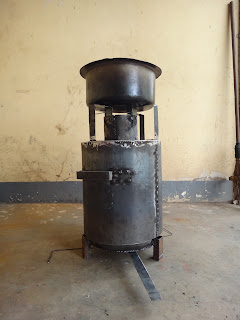In our final few days in Kigoma, we met with Grace, Fish, and Joram from JGI. DHE has worked closely with Grace and Fish in the past on our technologies. Grace They were able to give us a lot of feedback on the rocket stove and other projects. Grace told us that JGI has expanded the rocket stove to 26 villages. She anticipates more rocket stoves will be built this dry season.
Grace gave more information on JGI’s distribution method, saying that JGI’s distribution method of assisting in the building of hundreds of stoves in each village they have brought the rocket stove to has been successful. She wasn’t surprised to hear about our findings in Kalinzi where only a few stoves had been built. JGI needs to support the building of a critical number of stoves for the stove to catch on., she explained. This way, people don’t have a choice but to notice the stove. JGI does this by paying locals 1,000 shillings for each stove they build. She said that the price builders are asking for in Kalinzi might be significantly higher than this at 5,000 shillings because Kalinzi is relatively richer than many of the communities where JGI has distributed the stove and because firewood is more scarce in Kalinzi.
She then gave us some more technical feedback on the stove. She mentioned that the tray needed replacement and the clay tray broke especially quickly. JGI recommends using a metal tray design if the family can afford it, she said. Another issue she mentioned was that the stove was built too high as most cooking stools are built for shorter stoves. She said that JGI’s solution to this issue has been to encourage users to get higher stools. Grace also mentioned the difficulty some users have with cooking ugali. She then told us that one thing DHE could help develop was a rocket stove for charcoal.
A charcoal rocket stove would be beneficial for charcoals stove users. This way charcoal users could cut down on the amount of charcoal they consume which will decrease deforestation. Fish has built a prototype charcoal rocket stove at his house which we saw. He uses his charcoal rocket stove more than the regular rocket stove because charcoal is more readily available in his village and his family prefers to cook with charcoal. Compared to a regular charcoal stove, Fish’s charcoal rocket stove is cheaper, cooks faster, heats up faster, and lasts longer, for two years. It also uses two or three times less firewood. Fish says that a charcoal rocket stove is a more efficient use of wood all around compared to the traditional rocket stove.
His rocket stove is made to the height of the regular rocket stove but can be made shorter. It uses different molds and has a piece of metal with holes in it to hold the charcoal. He is looking to use only bricks and no metal in the future. Fish will be showing two villages how to build this stove in the coming weeks.
Grace gave us some more feedback on her use of the coffee husk stove too. She told us that she has used the stove daily for boiling water and making dog food. She said that the flame is good and the stove cooks well if the right material is used. Grace only uses a particular type of sawdust which is at a certain size, completely dry, and comes from a certain type of tree, and then she adds some palm press cake to make the burn better. She expressed some concern with the wire mesh insert which lasts only two months for her. Grace thinks that this limitation will make the stove unaffordable for many people in the villages.
Grace and Fish also gave us information on their views on briquetting. They both thought that it would be a great idea and hope that DHE can continue the project with them. They do think that a better mixture needs to be found before moving forward though. The quality of the briquettes, in that they cooked too quickly and smoked, of the newspaper and grasses briquettes needed to improved. They liked the durability of the coffee husk and newspaper briquettes though. Grace said that coffee husk, rice husk, and palm oil press cake are available in the areas they work with and thought that good briquettes made from these materials would be an excellent energy source. Fish has been unable to do much work with the briquettes thus far but is excited to move forward with the project.
Grace and Joram then talked to us about biogas in Kigoma. Joram was trained in 2008 to build biogas digesters. Since then, he has built six digesters, four in Kigoma and two in Kalinzi. The plant uses about two to four kilos of kitchen waste daily to run the stove for two or three hours on full gas for a 1000 liter tank design. Grace said one drawback is that a family of four cannot create this much waste. Nonetheless, certain groups of people are asking for the stove and digester to be built. Currently, Joram is building a digester at High Tech, a hotel and restaurant about five minutes away from JGI. This digester will use a 2000 liter tank and is costing High Tech about 500,000 shillings. It will provide enough fuel for four to five hours of cooking on full gas. This digester will also be underground which will make it last longer. Some of the systems Joram has built have had to be above ground due to rocky soil at the site. It will take builders six days to complete the project. After that, Joram will add five large buckets of cow dung to get the digester going, and then it’ll only require kitchen waste. Joram was very excited to show us his project and is also looking forward to potential collaboration with DHE.
.jpg)
.jpg)




































